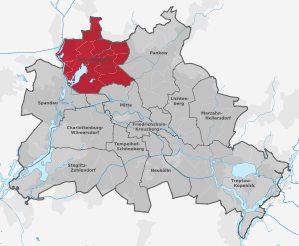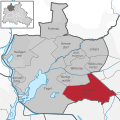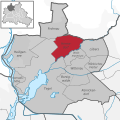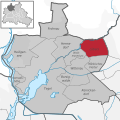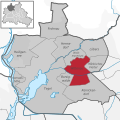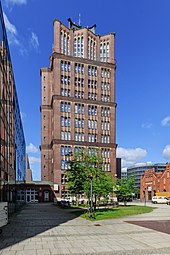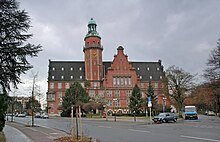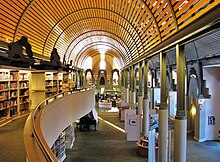Reinickendorf district
|
Reinickendorf 12th district of Berlin |
||||||||||||||||||||
|---|---|---|---|---|---|---|---|---|---|---|---|---|---|---|---|---|---|---|---|---|
| Coordinates | 52 ° 34 ′ 0 ″ N , 13 ° 21 ′ 0 ″ E | |||||||||||||||||||
| surface | 89.48 km² | |||||||||||||||||||
| Residents | 266,408 (Dec. 31, 2019) | |||||||||||||||||||
| Population density | 2977 inhabitants / km² | |||||||||||||||||||
| Proportion of foreigners | 16.2% (Dec. 31, 2016) | |||||||||||||||||||
| Unemployment rate | 8.6% (Nov. 30, 2019) | |||||||||||||||||||
| Post Code | 13403, 13405, 13407, 13409, 13435, 13437, 13439, 13465, 13467, 13469, 13503, 13505, 13507, 13509 | |||||||||||||||||||
Administration address |
Eichborndamm 215-239 13437 Berlin |
|||||||||||||||||||
| Website | berlin.de/ba-reinickendorf | |||||||||||||||||||
| Average age | 44.7 years (Dec. 31, 2016) | |||||||||||||||||||
| structure | ||||||||||||||||||||
| District key | 12 | |||||||||||||||||||
| Structure of the district |
11 districts |
|||||||||||||||||||
| politics | ||||||||||||||||||||
| District Mayor | Frank Balzer ( CDU ) | |||||||||||||||||||
| Deputy District Mayor | Uwe Brockhausen ( SPD ) | |||||||||||||||||||
| Allocation of seats ( district assembly ) | ||||||||||||||||||||
|
||||||||||||||||||||
Reinickendorf is the twelfth administrative district of Berlin and had a total of 266,408 inhabitants on December 31, 2019.
In terms of area, the fifth largest district is Tegeler See , a tributary of the Havel .
The headquarters of August Storck KG, one of the top-selling producers of confectionery in Europe, is located in the district.
The most famous buildings in Berlin-Reinickendorf include u. a. the Tegel Castle , the architectural style of the Brick Expressionism built Borsig tower and the residential buildings of the White City , to the Berlin Modernism Housing Estates belong.
geography
location
The district is located in the northwest of Berlin. The neighboring districts are Spandau in the south - west , Charlottenburg-Wilmersdorf in the south, Mitte in the south-east and Pankow in the east . The entire north borders on the Brandenburg district of Oberhavel .
Settlement structure
Its character is shaped by forests and waters, but its southern parts have many similarities in terms of development with the neighboring district of Wedding in the Mitte district . In addition, Reinickendorf is home to the White City settlement, built between 1929 and 1931, and the Märkische Viertel , which was created as a large housing estate from 1963 to 1974 and is home to over 30,000 people. In the remaining parts of the village, single house development predominates, which in some areas such as Hermsdorf and especially Frohnau also takes on a villa-like character.
Natural monuments
The fat Marie , a pedunculate oak in the Tegeler Forest , is considered the oldest tree in Berlin. Their age is estimated to be 500–800 years. The tallest tree on Berlin soil is also in the Tegel Forest. The so-called Burgsdorf larch was planted in 1795 and reached a height of 42.5 meters in 2012. The Humboldt oak in the castle park Tegel reached 7.75 meters the largest trunk circumference of a standing tree in Berlin.
Districts
The district is divided into eleven districts :




| District and locations |
Area (km²) |
Residents December 30, 2019 |
Inhabitants per square kilometer |
location |
|---|---|---|---|---|
| 1201 Reinickendorf | 10.5 | 83.909 | 7,991 | |
| 1202 Tegel | 33.7 | 36,986 | 1,098 | |
1203 Konradshöhe
|
2.2 | 6.004 | 2,729 | |
1204 Heiligensee
|
10.7 | 18,100 | 1,692 | |
| 1205 Frohnau | 7.8 | 16,814 | 2.156 | |
| 1206 Hermsdorf | 6.1 | 16.607 | 2,722 | |
1207 Waidmannslust
|
2.3 | 10,973 | 4,771 | |
| 1208 Lübars | 5.0 | 5,203 | 1,041 | |
| 1209 Wittenau | 5.9 | 24,656 | 4.179 | |
| 1210 Märkisches Viertel | 3.2 | 40,379 | 12,618 | |
| 1211 Borsigwalde | 2.0 | 6,777 | 3,389 |
Ponds, basins and lakes
Ponds 2–18 are bodies of water in Frohnau and are located in the area of the inland dune there ; due to their round shape, they are also called the “Blue Eyes of Frohnau”. In the other districts, too, there are round and almost round ponds, and some ponds are embedded in the damp green areas. The basins are often rain retention basins (RHB) and therefore only temporarily filled with water.
|
1. Hubertussee ( location ) Frohnau 2. Mushroom Pond ( location ) |
28a Mäusewinkelbecken ( location ) Lübars 29. Rosenthal basin ( location ) Lübars 44. Buchholzendenbecken ( location / location ) Waidmannslust
|
51. Stubbichtbecken ( location ) Waidmannslust 52. Mühlenfeldteich ( location ) Waidmannslust 60. Achtrutenteich ( location ) Wittenau 64. Kiesteich at the airport lake ( location ) Tegel |
history
1920-1945
With the Greater Berlin Act in 1920, the six rural communities Reinickendorf , Wittenau , Tegel , Heiligensee , Hermsdorf near Berlin and Lübars , the western part of the rural community Rosenthal and the manor districts (or parts of it) Frohnau , Tegel-Schloss , Jungfernheide -Nord and Tegel-Forst-Nord merged to form the Reinickendorf district.
1945–1990
After 1945, the Reinickendorf district in the “ four-power city ” of Berlin belonged to the French sector and thus to West Berlin . In 1946, a municipal parliament was elected in Reinickendorf for the first time since Hitler's " seizure of power " in 1933 .
Since 1990
The latest development is the design of the (factory workers) settlement Borsigwalde as a separate district.
population
| year | Residents |
|---|---|
| 1925 | 105,467 |
| 1933 | 164.319 |
| 1939 | 200,531 |
| 1946 | 192.201 |
| 1950 | 205.930 |
| 1961 | 215,892 |
| 1970 | 238.736 |
| 1987 | 238,671 |
| 2000 | 245,644 |
| 2009 | 241.065 |
| 2016 | 260.253 |
| 2017 | 263.920 |
As of December 31, 2019, the Reinickendorf district had 266,408 inhabitants and therefore has the third lowest population of all Berlin districts after the Spandau and Treptow-Köpenick districts .
Due to the proportion of water and forest areas ( Tegeler See and Forest) in the total area of 89.5 square kilometers in connection with the loose development in many districts, the average population density on the cut-off date was 2,977 inhabitants per square kilometer, which is the third lowest value of all Representing Berlin districts.
On December 31, 2016, the proportion of foreigners was 16.2%, while the proportion of the population with a migration background was 30.6%. In November 2019, 9,867 people were registered as unemployed in the district, the unemployment rate was 8.6%. As of December 31, 2016, the median age of the population was 44.7 years.
→ See also: List of districts and districts of Berlin .
economy
Companies
In 2013, 9,168 companies were registered in the Reinickendorf district. The manufacturing sector is particularly well represented. The largest employers (as of 2020) in the district include, among others
- August Storck , confectionery, company headquarters
- RENAFAN GmbH , care services, company headquarters
- Vivantes Netzwerk für Gesundheit GmbH, Germany's largest municipal clinic group, company headquarters
- State Mint Berlin , company headquarters
- Borsig , mechanical and plant engineering, subsidiary of the KNM Group
- Freiberger Lebensmittel GmbH & Co. Produktions- und Vertriebs KG, subsidiary of Südzucker AG
- G-Elit Präzisionswerkzeug GmbH, subsidiary of the Gühring group
- Piepenbrock Service GmbH + Co. KG , Services, Berlin Dependance
- Meisterbäckerei Steinecke , production facility
- OTIS GmbH & Co. OHG , Germany headquarters
Craft
In 2012, of the 30,862 craft businesses based in Berlin, a total of 2,279 were registered in Reinickendorf.
Infrastructure
Private transport
The A 111 motorway and the 96 federal road run through Reinickendorf.
Transportation
The underground lines U6 and U8 as well as the S-Bahn lines S1, S25, S26 and S85 open up the district for public transport .
Air traffic
The Tegel airport is located in the same district .
politics
District Office
The district office has been composed of the following city councils since 2016:
| District Councilor | Political party | Department |
|---|---|---|
| Frank Balzer , District Mayor | CDU | Finance, Human Resources, Urban Development and the Environment |
| Uwe Brockhausen, Deputy District Mayor | SPD | Economy, health, integration and social issues |
| Katrin Schultze-Berndt | CDU | Building, education and culture |
| Tobias Dollase | independent,
for CDU |
Youth, family, school and sport |
| Sebastian Maack | AfD | Citizens' services and regulatory affairs |
The Reinickendorf district is represented at the state level in the Council of Mayors and in the Resource Management Working Group .
District Assembly
In the first election for the District Assembly (BVV), the SPD emerged as the winner with an absolute majority. It reached its peak in the 1948 election with an election result of 67.9% of the vote - the highest election result for a party in Reinickendorf since then. As the strongest parliamentary group, it was able to maintain its majority in the BVV until the 1981 election.
The Reinickendorfer CDU then managed to secure a majority in parliament in 1981, and in 1985 and 1999 even an absolute majority.
In 1989 the Social Democrat Detlef Dzembritzki succeeded in becoming mayor for six years. In the 1995 election, however, he failed because of the Christian Democrat Marlies Wanjura , who was elected as the first woman to be the district mayor of Reinickendorf. With it, the CDU achieved its highest result in 1999 of 56.5% of the votes cast. In 2009, Wanjura resigned from office with the election of her successor, the previous District Councilor Frank Balzer .
From 2011 the CDU and the Greens formed a counting community in the BVV. Since 2016 the CDU and SPD have formed a counting community in the BVV.
Jurisdiction
The district court of Wedding is responsible for general civil law in the Reinickendorf district .
Bundestag elections
In the federal elections in 2013, the Berlin-Reinickendorf district turned out to be the “most average constituency in Germany”. The results of the CDU, SPD, Left Party, Greens, FDP and AfD deviated only insignificantly from the federal result - on average by 0.8 percentage points and thus lower than in any other constituency.
coat of arms
The current coat of arms of the Reinickendorf district was awarded by the Berlin Senate on November 28, 1955.
Description of the coat of arms: In a black shield a golden sloping bar, covered with a running red fox and accompanied by six (3: 3) golden ears of wheat. A red three-tower wall crown rests on the shield , the central tower of which is covered with a small Berlin coat of arms .
Justification for the coat of arms: The motif of the " Reineke Fuchs " as a talking coat of arms was taken from the Reinickendorf coat of arms. On the one hand, the golden ears of corn symbolize the agricultural character of the former independent communities in the district. On the other hand, the number of them symbolize the six incorporated communities: Heiligensee , Hermsdorf , Lübars , Reinickendorf , Tegel , Wittenau .
Partnerships

Town twinning
|
International Antony , France since 1966 Royal Borough of Greenwich , England since 1966 Kiryat Ata , Israel since 1976
|
National
|
Friendly contacts
Beyond the town twinning, Reinickendorf maintains friendly contacts with Breslau , Burkina Faso , Dénia , Catalonia , Kiev , Meseritz , Minsk , Orkney , Saint Petersburg , Zielenzig , Templewo , Washington, DC , Volgograd , Woltschja Gora, Lichtenfels (Bavaria), the Oberhavel district (Brandenburg), the district of Schmalkalden-Meiningen ( Thuringia ) and Zeltingen-Rachtig ( Rhineland-Palatinate ).
Police and military
Directorate 1 of the Berlin police is responsible for the Reinickendorf and Pankow districts. At Tegel Airport, the federal police are responsible for border protection and aviation security.
The Federal Ministry of Defense's flight readiness helicopters are stationed on the military part of the airport in Tegel and are expected to remain there until 2029.
education
schools
- (Selection)
- Scharfenberg Island School Farm
- Humboldt Gymnasium
- Romain Rolland High School
- Friedrich-Engels-Gymnasium
- Gabriele-von-Bülow-Gymnasium
- European high school Bertha von Suttner
- Catholic School Salvator
- Max Beckmann High School
- Gustav Freytag School
- Paul Löbe School
- Bettina von Arnim School
- Jean Chandler School
- Benjamin Franklin School
- Carl Bosch School
- Julius Leber School
- Herbert Hoover School
- Albrecht Haushofer School
University
- German University in Cairo - Berlin Campus
Libraries
The district has five public libraries in the library system Stadtbibliothek Reinickendorf . In 2012 the Reinickendorf City Library recorded around 1.5 million loans from around 300,000 items.
- Humboldt Library
- Library in the Märkisches Viertel
- Library at the Schäfersee
- Reinickendorf-West district library
- District library Frohnau
Culture
Buildings
- Tegel Castle
- The Buddhist house in Frohnau
- Großkopf farm
- Blessing Church
- White City , part of the Berlin Modernism settlements and a UNESCO World Heritage Site since 2008
- Small Latvian colony
- Adria canned and dried vegetable factory
Festivals and Celebrations
- Schlager Olymp in Lübars
- Tegeler Hafenfest on the Greenwich promenade in Tegel
- Easter fire in Frohnau
District personalities
- Petra A. Bauer , author
- Detlef Dzembritzki , politician
- Fil , author, comic artist, comedian
- Anne Julia Hagen , Miss Germany 2010
- Thomas Häßler , soccer player, world champion 1990
- Mariama Jamanka , bobsleigh athlete, world champion 2017/2019, Olympic champion 2018
- Reinhard Mey , musician
- Andreas Neuendorf , soccer player
- Franz Neumann , politician
- Playboy 51 , city original
- Robert Russ , music producer, 2018 Grammy Award winner
- Marie Schlei , politician
- Desirée Schumann , soccer player
- Frank Steffel , politician
- Farin Urlaub , singer and guitarist, founding member of the rock band " Die Ärzte "
- Marlies Wanjura , politician
Sports
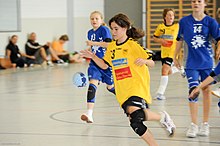
Around 200 sports clubs in the district offer a wide range of sporting activities. In the field of top-class sport, a number of clubs are based in Reinickendorf. The Füchse Berlin professional club emerged from Füchsen Berlin Reinickendorf . He currently plays in the handball Bundesliga . The Berlin Flamingos are represented in the baseball Bundesliga (as of 2019). Several European and world champions have emerged from the Tegel 1886 rowing club and the LG Nord Berlin athletics club .
In the field of popular sports, the equestrian and water sports clubs are typical of the district. In the northern part of Lübars there is a large number of riding stables. Riding as a leisure activity, show jumping and dressage riding have a long tradition here. Equestrian tournaments are also held in Lübars.
Reinickendorf, with its many water areas, is one of the popular destinations for anglers. Numerous fishing clubs are represented in the district.
There were also at least 14 fitness studios in the district in 2016. Muscle building programs , endurance training as well as aerobics and Pilates courses are offered there.
Others
In a district comparison, Reinickendorf has the largest number of Berlin dogs per inhabitant. There were around 41 dogs for every 1000 residents in 2018. The most popular dog breeds in Reinickendorf include u. a. the labrador and the golden retriever.
literature
- Michael Zaremba : Reinickendorf in the course of history. District Chronicle. Bebra, Berlin 1999, ISBN 3-930863-63-4 .
- Ralf Schmiedecke: Berlin-Reinickendorf. Sutton 2003, ISBN 978-3-89702-587-5 (series of archive images ).
- Gerd Koischwitz; Wilhelm Möller oHG (Hrsg.): Six villages in swamp and sand - history of the Reinickendorf district of Berlin. The North Berliner, Berlin 1983.
Web links
Individual evidence
- ↑ a b c d Statistical Report - Residents in the State of Berlin on December 31, 2016 (PDF; 3.1 MB). Office for Statistics Berlin-Brandenburg . Retrieved June 26, 2017.
- ↑ November: Unemployment in Berlin at its lowest point . In: Berliner Zeitung , accessed on January 11, 2020.
- ↑ Numbering according to the district key
- ↑ Net sales of the leading European companies in the confectionery industry in 2014. In: Statista , accessed on January 11, 2020
- ↑ Die Dicke Marie im Tegeler Forst, Senate Administration, accessed on January 17, 2020.
- ↑ The thickest, tallest, and oldest trees in Berlin, monumental trees, accessed on January 24, 2020.
- ↑ Residents in the State of Berlin on December 31, 2019, data from the Berlin-Brandenburg Statistics Office , accessed on August 27, 2020 ( PDF file ) ( help on this ).
- ↑ The basin of 380 m² was laid out in the 1970s on the property in the driver path 28/30 (previously Planstrasse 7 No. 12). A lockable ditch connects with the Tegeler Fließ
- ↑ Updated population figures from December 31, 2019 by the Berlin-Brandenburg Statistics Office , accessed on June 10, 2020 ( [1] ) ( help on this ).
- ↑ Berlin Economy in Figures - 2013 edition. Ed. by IHK Berlin , accessed on June 29, 2017.
- ^ Members of the Reinickendorf District Office of Berlin. January 23, 2017. Retrieved February 15, 2017 .
- ^ Council of Mayors, accessed May 18, 2019
- ↑ Small request from the FDP, accessed on May 18, 2019
- ↑ a b Elections to the district council meetings 2016 , accessed on October 28, 2016
- ↑ Election 2016 Berlin - Reinickendorf ,, rbb, accessed on January 11, 2020.
- ↑ tagesschau.de: Germany's most unusual constituencies. Retrieved on February 15, 2018 (German).
- ^ National emblem of Berlin - district coat of arms , accessed on January 17, 2020.
- ↑ Readiness helicopters remain in Tegel. In: Berliner Morgenpost , accessed on January 21, 2020.
- ↑ Easter fire in Frohnau , Kindaling, accessed on January 19, 2020.
- ↑ Sports clubs in Reinickendorf , accessed on January 11, 2020.
- ↑ Quiet, brown! . In: Der Tagesspiegel , accessed on August 16, 2017.
- ↑ Fishing waters in Berlin, accessed on July 1, 2017.
- ^ Fitness studios in Reinickendorf. At: Berlin.de , accessed on July 1, 2017.
- ↑ Number of dog owners and dogs in the federal state of Berlin by district in 2018 , Statista, accessed on January 17, 2020.

